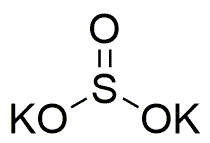Potassium sulfite is widely utilized in research focused on:
- Food Preservation: It acts as a preservative in food products, preventing spoilage and maintaining freshness by inhibiting microbial growth.
- Photography: Used in the photographic industry, it helps in the development process by controlling the oxidation of developing agents, ensuring high-quality images.
- Water Treatment: Potassium sulfite is effective in removing chlorine from water, making it suitable for various industrial applications, including cooling systems and wastewater treatment.
- Pharmaceuticals: It serves as an antioxidant in pharmaceutical formulations, enhancing the stability and shelf life of sensitive compounds.
- Laboratory Reagents: Commonly used in laboratories as a reducing agent, it facilitates various chemical reactions, particularly in organic synthesis and analytical chemistry.
General Information
Properties
Safety and Regulations
Applications
Potassium sulfite is widely utilized in research focused on:
- Food Preservation: It acts as a preservative in food products, preventing spoilage and maintaining freshness by inhibiting microbial growth.
- Photography: Used in the photographic industry, it helps in the development process by controlling the oxidation of developing agents, ensuring high-quality images.
- Water Treatment: Potassium sulfite is effective in removing chlorine from water, making it suitable for various industrial applications, including cooling systems and wastewater treatment.
- Pharmaceuticals: It serves as an antioxidant in pharmaceutical formulations, enhancing the stability and shelf life of sensitive compounds.
- Laboratory Reagents: Commonly used in laboratories as a reducing agent, it facilitates various chemical reactions, particularly in organic synthesis and analytical chemistry.
Documents
Safety Data Sheets (SDS)
The SDS provides comprehensive safety information on handling, storage, and disposal of the product.
Product Specification (PS)
The PS provides a comprehensive breakdown of the product’s properties, including chemical composition, physical state, purity, and storage requirements. It also details acceptable quality ranges and the product's intended applications.
Certificates of Analysis (COA)
Search for Certificates of Analysis (COA) by entering the products Lot Number. Lot and Batch Numbers can be found on a product’s label following the words ‘Lot’ or ‘Batch’.
Numéro de catalogue
Numéro de lot/série
Certificates Of Origin (COO)
This COO confirms the country where the product was manufactured, and also details the materials and components used in it and whether it is derived from natural, synthetic, or other specific sources. This certificate may be required for customs, trade, and regulatory compliance.
Numéro de catalogue
Numéro de lot/série
Safety Data Sheets (SDS)
The SDS provides comprehensive safety information on handling, storage, and disposal of the product.
DownloadProduct Specification (PS)
The PS provides a comprehensive breakdown of the product’s properties, including chemical composition, physical state, purity, and storage requirements. It also details acceptable quality ranges and the product's intended applications.
DownloadCertificates of Analysis (COA)
Search for Certificates of Analysis (COA) by entering the products Lot Number. Lot and Batch Numbers can be found on a product’s label following the words ‘Lot’ or ‘Batch’.
Numéro de catalogue
Numéro de lot/série
Certificates Of Origin (COO)
This COO confirms the country where the product was manufactured, and also details the materials and components used in it and whether it is derived from natural, synthetic, or other specific sources. This certificate may be required for customs, trade, and regulatory compliance.


